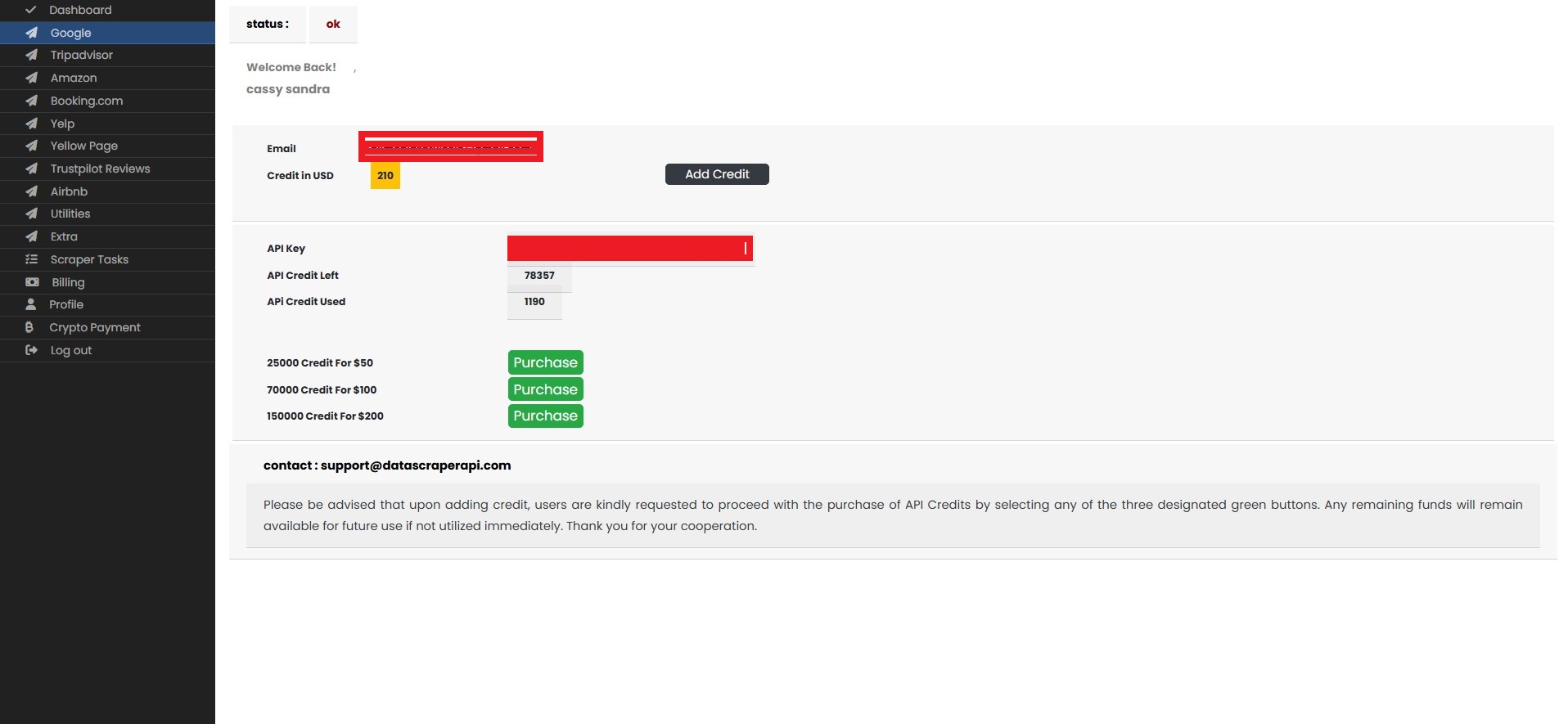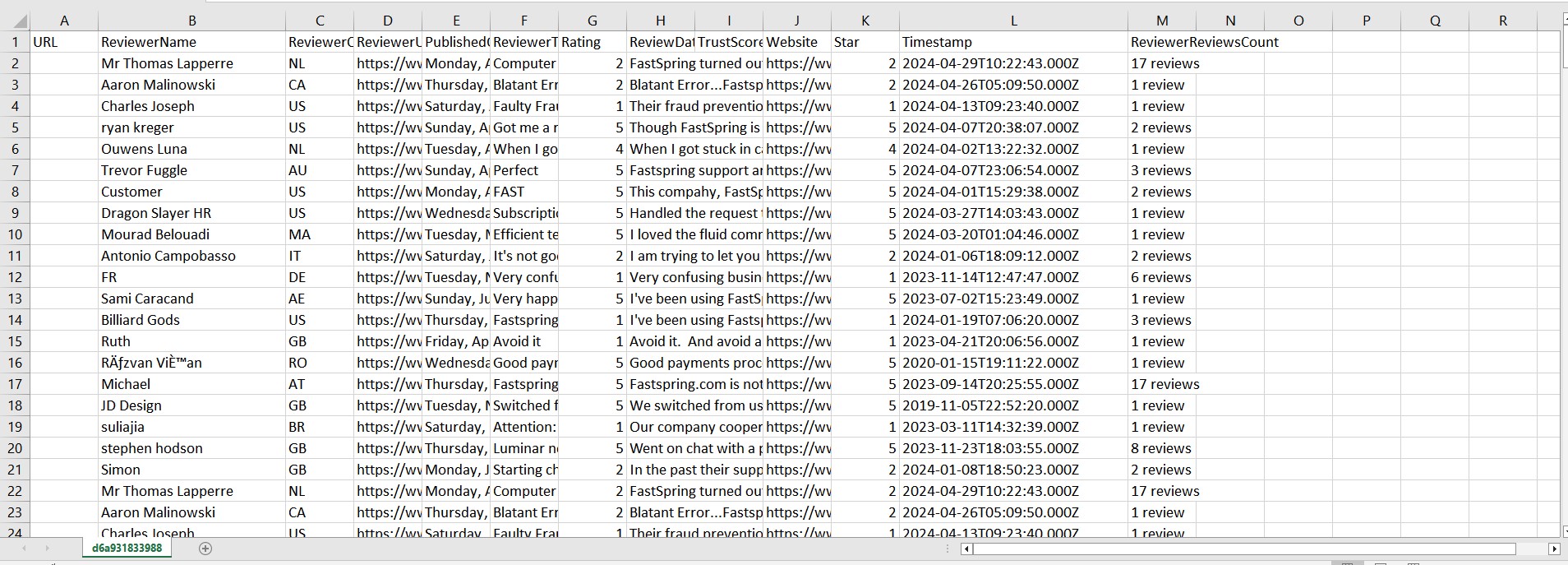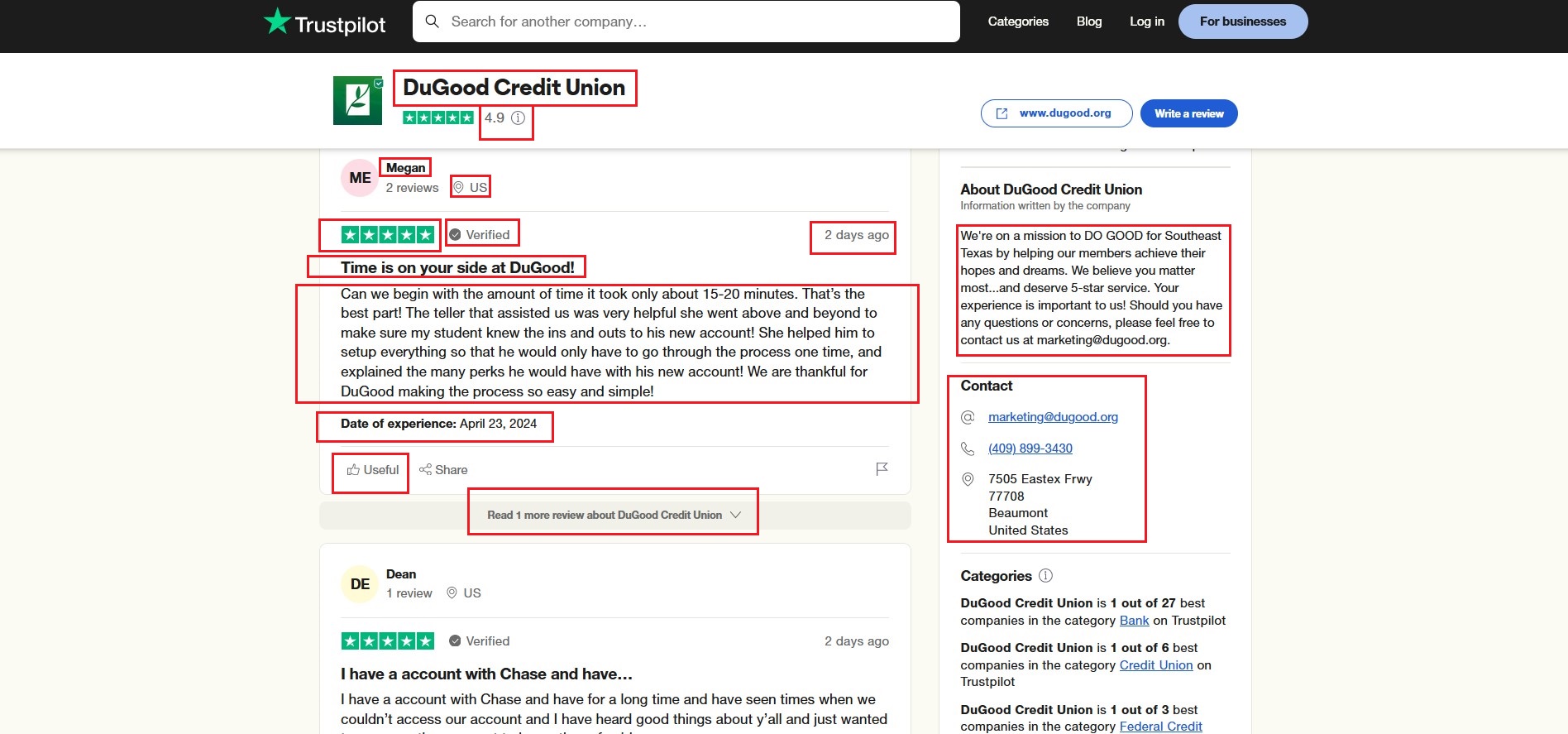Trustpilot Reviews Scraper
By / / No Comments

Table of Contents
ToggleUnderstanding Trustpilot Reviews
What is Trustpilot?
Trustpilot serves as a digital marketplace of opinions, offering a platform for consumers to share their experiences with businesses and for companies to showcase their reputation. It’s essentially a community-driven review platform where people can rate and review businesses based on factors such as product quality, customer service, and overall satisfaction.
Users can browse through a wide range of businesses across different industries, from restaurants and retail stores to online services and e-commerce platforms. Each business listing on Trustpilot includes a collection of reviews and ratings provided by customers who have interacted with that particular company.
For consumers, Trustpilot provides valuable insights into the reliability and trustworthiness of businesses before making purchasing decisions. They can read firsthand accounts from other customers to gauge the quality of products or services offered by a company.
On the other hand, businesses can leverage Trustpilot to build and maintain their online reputation. They can engage with customers by responding to reviews, both positive and negative, and use the platform as a tool for gathering feedback to improve their offerings and customer experience.
Trustpilot employs a transparent and democratic review system, where all reviews are visible to the public, and businesses cannot remove or manipulate them. This commitment to transparency fosters trust and authenticity within the Trustpilot community, ensuring that consumers have access to unbiased and genuine feedback.
How to use our Trustpilot Reviews Scraper in Cloud solution?
For no code users (user without coding knowledge) :
Step 1 :
users needs to login to the WEB UI / Web Dashboard first > Dashboard. An account is needed in order to login, existing users can login, new users should sign up before.
after, login the UI will look like this

Step 2 :
User should navigate to the trustpilot item in the left side menu and Click on it
Step 3 :
The scraping dashboard will look like this, which actually takes many inputs from users for scraping.

here, user should input the target company website domain.tld in input area / target area. Also, the data limits and types in data tab. Then create a task which can be found in the scraper tasks dashboard.
In case someone requires help, there is a TUTORIAL button present for written specific instruction
Step 4 :
Finally, you can check the task status in Scraper Tasks Dashboard

For Developers :
For them, we have API documentation. It is simple API using GET / POST combination.
Remember, the whole DataScraperAPI API system is TASK based. Further information can be found in Documentation
Data Formats Available
Currently we provide CSV data with proper headers. JSON data can be available on request.
Again,
CSV
JSON (on request via API)
Expected Records :
- URL
- Reviewer Name
- Reviewer country
- Reviewer URL
- Published on
- Rating
- Review Data
- Trustscore
- Website
- Star
- Timestamp
- Reviews Count
- Reviewer Reviewed

Importance of Trustpilot reviews for businesses
- Social Proof: Trustpilot reviews serve as powerful social proof for your business. Potential customers are more likely to trust the opinions of fellow consumers over traditional marketing messages. Positive reviews on Trustpilot validate your brand’s credibility and reassure potential customers that they are making the right choice by choosing your products or services.
- SEO Benefits: Trustpilot reviews can positively impact your search engine optimization (SEO) efforts. Search engines like Google often feature Trustpilot ratings and reviews in search results, especially for local businesses. Having a high volume of positive reviews and a strong overall rating can improve your visibility in search engine results pages (SERPs) and attract more organic traffic to your website.
- Enhanced Reputation Management: Trustpilot provides businesses with a platform to actively manage their online reputation. By monitoring and responding to reviews, businesses can demonstrate their commitment to customer satisfaction and address any concerns or negative feedback in a timely and professional manner. This proactive approach to reputation management can help mitigate potential damage to your brand’s image and build trust with both existing and potential customers.
- Consumer Insights: Trustpilot reviews offer valuable insights into the preferences, expectations, and pain points of your target audience. By analyzing customer feedback, businesses can gain a deeper understanding of what drives customer satisfaction and identify areas for improvement in their products, services, or customer experience. This data-driven approach enables businesses to make informed decisions and optimize their offerings to better meet the needs of their customers.
- Competitive Advantage: Positive reviews on Trustpilot can give your business a competitive edge in the marketplace. When consumers are comparing options, they are more likely to choose a business with a higher rating and more positive reviews over competitors with lower ratings or fewer reviews. By leveraging Trustpilot as a platform to showcase your reputation and customer satisfaction, you can differentiate your brand and stand out from the competition.


What is a Trustpilot Reviews Scraper?
A Trustpilot Reviews Scraper is a software tool or script designed to extract and collect reviews and related data from the Trustpilot website. As a programmer, here’s a breakdown of how it works:
- Web Scraping: The Trustpilot Reviews Scraper uses web scraping techniques to navigate the Trustpilot website and extract specific information from its pages. This involves sending HTTP requests to Trustpilot’s servers and parsing the HTML content of the web pages to extract relevant data, such as review text, ratings, dates, and reviewer information.
- Automated Crawling: The scraper typically employs an automated crawling mechanism to systematically navigate through Trustpilot’s pages and scrape multiple reviews. It may start from a specified Trustpilot page, such as a company’s profile, and then follow links to individual review pages to collect more data.
- Data Extraction: Once the relevant web pages are fetched, the scraper extracts the desired data from the HTML content using techniques like regular expressions, XPath, or CSS selectors. It identifies specific HTML elements that contain the review information and extracts the text and metadata accordingly.
- Data Parsing and Structuring: After extracting the raw data from Trustpilot’s web pages, the scraper parses and structures it into a usable format, such as JSON or CSV. This involves cleaning up the data, removing any unnecessary HTML tags or formatting, and organizing it into a structured format that can be easily processed and analyzed.
- Storage and Output: Finally, the scraped reviews and related data are typically stored in a database or exported to a file for further analysis or usage. Depending on the requirements, the scraper may save the data locally on the user’s machine or upload it to a cloud storage service for accessibility and sharing.
Benefits of Using a Trustpilot Reviews Scraper
- Competitive Analysis: A Trustpilot Reviews Scraper enables you to gather reviews not only for your own business but also for your competitors. By analyzing competitor reviews, you can identify their strengths and weaknesses, understand customer pain points, and uncover opportunities to differentiate your brand and improve your offerings.
- Market Research: Scrutinizing reviews scraped from Trustpilot allows you to gain deep insights into market trends, customer preferences, and emerging demands. You can identify common themes, sentiments, and recurring issues among customers, helping you tailor your products or services to better meet consumer needs and stay ahead of the competition.
- Identifying Customer Pain Points: By extracting and analyzing Trustpilot reviews, you can pinpoint specific pain points or areas of dissatisfaction that customers may have with your products, services, or overall customer experience. This information is invaluable for making data-driven improvements and addressing customer concerns to enhance satisfaction and loyalty.
- Content Generation: Trustpilot reviews can serve as a goldmine for generating authentic user-generated content. By scraping positive reviews, testimonials, and customer success stories, you can leverage this content in your marketing materials, social media campaigns, and website to build trust, credibility, and social proof around your brand.
- Reputation Management: Monitoring and analyzing Trustpilot reviews in real-time with a scraper allows you to proactively manage your brand’s online reputation. By promptly addressing negative feedback, resolving customer issues, and amplifying positive reviews, you can maintain a positive brand image, strengthen customer trust, and mitigate potential damage to your reputation.
- SEO and Online Visibility: Incorporating Trustpilot reviews into your website or online listings can improve your search engine optimization (SEO) efforts and enhance your online visibility. Positive reviews and ratings displayed prominently on your website or in search engine results can attract more clicks, increase website traffic, and ultimately drive conversions and revenue.
- Customer Insights and Personalization: Analyzing Trustpilot reviews can provide valuable insights into your target audience’s demographics, preferences, and behaviors. Armed with this knowledge, you can tailor your marketing messages, product offerings, and customer experiences to resonate more effectively with your target market, driving engagement and loyalty.
Factors to Consider When Choosing a Trustpilot Reviews Scraper
- Data Accuracy and Reliability: Ensure that the scraper you choose can extract reviews from Trustpilot accurately and reliably. Look for a scraper that can handle variations in Trustpilot’s website structure and updates to ensure consistent data extraction.
- Customizability: Consider whether the scraper allows you to customize the data extraction process to meet your specific needs. Look for features such as the ability to specify search criteria, filter reviews based on ratings or keywords, and extract additional metadata such as reviewer demographics.
- Ease of Use: Opt for a Trustpilot Reviews Scraper that is user-friendly and intuitive, even for non-technical users. A simple interface and clear instructions can streamline the data extraction process and minimize the learning curve for your team.
- Scalability: Assess whether the scraper can handle large volumes of data efficiently. Choose a solution that can scale to accommodate your growing needs and extract reviews from multiple Trustpilot profiles or categories simultaneously without compromising performance.
- Compliance and Ethics: Ensure that the scraper complies with Trustpilot’s terms of service and respects ethical guidelines for web scraping. Look for features such as rate limiting, IP rotation, and user-agent rotation to minimize the risk of being detected or blocked by Trustpilot’s servers.
- Data Security and Privacy: Verify that the scraper takes appropriate measures to protect the privacy and security of the extracted data. Choose a solution that encrypts data transmission, stores data securely, and provides options for data anonymization or pseudonymization to comply with data protection regulations.
- Support and Updates: Consider the level of support and maintenance provided by the scraper’s developers. Look for a solution that offers responsive customer support, regular updates to address any changes or issues, and comprehensive documentation to help you troubleshoot problems.
- Cost and Value: Evaluate the pricing structure of the scraper and consider the overall value it provides relative to its cost. Look for a solution that offers transparent pricing with no hidden fees, flexible subscription options, and a good balance between features and affordability.
Legal and Ethical Considerations
- Compliance with Terms of Service: Before using a Trustpilot Reviews Scraper, carefully review Trustpilot’s terms of service and ensure that your use of the scraper aligns with their guidelines. Violating Trustpilot’s terms could result in legal consequences, such as being banned from the platform or facing legal action.
- Respect for Intellectual Property: Ensure that the Trustpilot Reviews Scraper does not infringe on any copyrights or intellectual property rights belonging to Trustpilot or other users. Scraping content without permission could lead to legal liabilities, such as copyright infringement claims or cease and desist orders.
- Data Protection and Privacy: Be mindful of data protection laws, such as the General Data Protection Regulation (GDPR) in the European Union, when scraping reviews from Trustpilot. Ensure that the scraper collects and handles personal data in compliance with relevant regulations, including obtaining consent from individuals when necessary and implementing appropriate security measures to protect user privacy.
- Transparency and Accountability: Be transparent with your audience about how you collect and use Trustpilot reviews. Clearly disclose that you are using reviews from Trustpilot and provide information on how they are being used, such as for market research or improving products and services. Additionally, take accountability for the data you collect and ensure that it is used responsibly and ethically.
- Fair Use and Attribution: When using Trustpilot reviews in your marketing materials or on your website, respect the principles of fair use and provide proper attribution to the original source. Avoid misrepresenting or altering reviews in a way that could be misleading or deceptive to consumers.
- Avoiding Deceptive Practices: Do not engage in deceptive practices or manipulation when using Trustpilot Reviews Scrapers. This includes artificially inflating review ratings, posting fake reviews, or misleading consumers about the authenticity of the reviews. Such practices not only violate Trustpilot’s guidelines but also erode trust and credibility with your audience.
- Ethical Use of Data: Use the data collected from Trustpilot reviews ethically and responsibly. Avoid using scraped data to engage in unethical or manipulative marketing tactics, such as targeting vulnerable populations or exploiting sensitive information for commercial gain.
Tips for Maximizing the Benefits of a Trustpilot Reviews Scraper
- Set Clear Objectives: Before diving into scraping Trustpilot reviews, define your goals and objectives. Are you looking to gather insights for product improvement, competitor analysis, or reputation management? Setting clear objectives will help you focus your scraping efforts and extract the most relevant data.
- Refine Your Search Criteria: Use advanced search parameters to narrow down your search and target specific businesses, industries, or geographic locations. By refining your search criteria, you can ensure that you’re extracting reviews that are most relevant to your needs, saving time and resources.
- Monitor Trends Over Time: Continuously scrape Trustpilot reviews over time to monitor trends and changes in customer sentiment. By tracking fluctuations in review volume, ratings, and sentiment, you can identify emerging issues, track the effectiveness of your strategies, and adapt your approach accordingly.
- Segment and Analyze Data: Segment the scraped reviews based on various criteria, such as ratings, keywords, or reviewer demographics, to uncover actionable insights. Analyze patterns and trends within each segment to identify common themes, customer preferences, and areas for improvement.
- Benchmark Against Competitors: Compare your business’s Trustpilot reviews against those of your competitors to benchmark performance and identify competitive advantages. Analyze differences in ratings, sentiment, and customer feedback to understand where you stand relative to your competitors and develop strategies to differentiate your brand.
- Leverage Positive Reviews: Use positive reviews scraped from Trustpilot to amplify your brand’s reputation and credibility. Incorporate positive testimonials into your marketing materials, website, and social media channels to build trust with potential customers and showcase your commitment to customer satisfaction.
- Address Negative Feedback Promptly: Pay close attention to negative reviews scraped from Trustpilot and respond promptly and professionally. Address customer concerns, offer solutions, and demonstrate your commitment to resolving issues. By addressing negative feedback in a transparent and proactive manner, you can turn dissatisfied customers into loyal advocates for your brand.
- Track and Measure Impact: Track key performance indicators (KPIs) related to your Trustpilot reviews, such as review volume, average rating, and response rate, to measure the impact of your efforts. Monitor changes in KPIs over time and assess the effectiveness of your strategies in improving customer satisfaction and driving business outcomes.
Common Challenges and How to Overcome Them
- Website Structure Changes: Trustpilot may periodically update its website structure, which can break your scraper’s functionality. To overcome this challenge, regularly monitor Trustpilot’s website for changes and update your scraper’s code accordingly. Implement robust error handling mechanisms to gracefully handle unexpected changes and prevent your scraper from crashing.
- Rate Limiting and IP Blocking: Trustpilot may impose rate limits or block IP addresses that make too many requests in a short period, which can disrupt your scraping activities. To mitigate this risk, implement rate limiting in your scraper to throttle the number of requests sent to Trustpilot and avoid triggering rate limits. Rotate IP addresses or use proxies to distribute requests and prevent IP blocking.
- Captcha Challenges: Trustpilot may use captcha challenges to verify that requests are coming from real users and not automated bots. Captchas can hinder your scraping efforts by requiring manual intervention to solve them. Consider integrating captcha-solving services or using headless browsers with captcha support in your scraper to automate the captcha-solving process and minimize disruptions.
- Dynamic Content Loading: Trustpilot may use dynamic content loading techniques, such as AJAX or JavaScript, to render reviews dynamically after the initial page load. This can pose challenges for traditional web scrapers that rely on static HTML content. To overcome this challenge, use headless browsers or browser automation tools in your scraper to simulate user interactions and dynamically fetch content rendered by JavaScript.
- Data Formatting and Cleaning: Raw data scraped from Trustpilot may contain inconsistencies, formatting errors, or irrelevant information that need to be cleaned and formatted properly for analysis. Implement data cleaning and normalization routines in your scraper to standardize the format of scraped data, remove duplicate entries, and filter out irrelevant information. Use regular expressions or string manipulation functions to extract relevant data fields and discard noise.
- Handling Large Volumes of Data: Scraping large volumes of reviews from Trustpilot can strain system resources and slow down your scraper’s performance. Optimize your scraper’s code and algorithms to handle large datasets efficiently. Implement pagination and batch processing techniques to fetch reviews in smaller chunks and minimize memory usage. Consider using distributed computing frameworks or cloud-based solutions to scale your scraper and handle increased workloads.
- Legal and Ethical Compliance: Ensure that your Trustpilot Reviews Scraper complies with Trustpilot’s terms of service and respects ethical guidelines for web scraping. Avoid aggressive scraping techniques that could disrupt Trustpilot’s services or violate its policies. Be transparent about your scraping activities and use scraped data responsibly and ethically to protect your brand’s reputation and comply with legal regulations.
